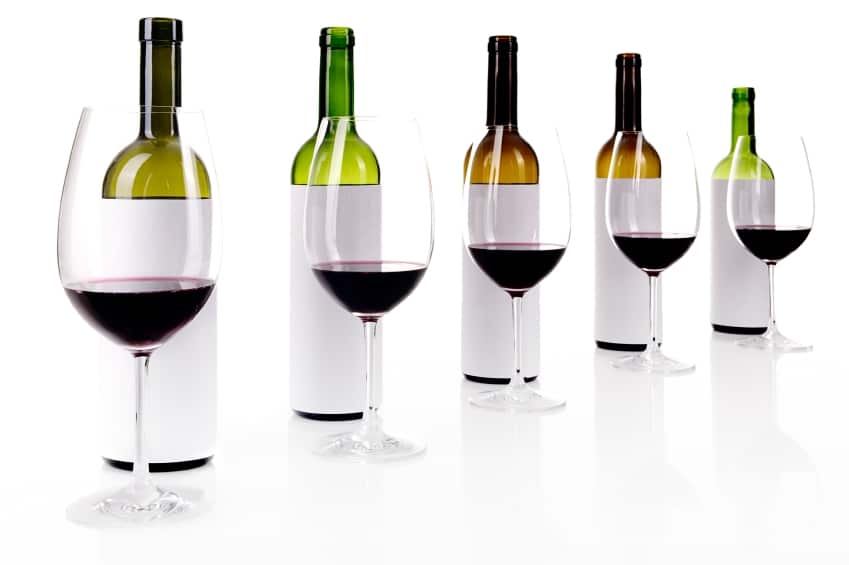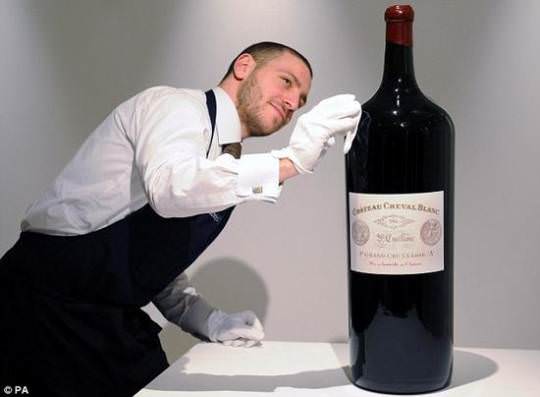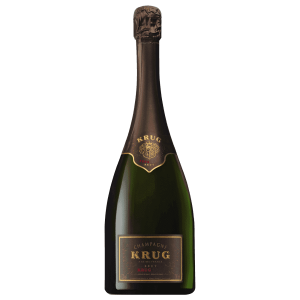
Wine Bottle Sizes
The art of making and enjoying wine has been around for thousands of years but the wine bottle as we know it today is a much more recent invention.
In the Egyptian and Grecian era of winemaking wine was stored in clay bottles and it was the Romans who introduced glass-blowing techniques and glass bottles to the wine industry.
But it wasn’t until the 19th century that bottles could be manufactured to anything like a standardized size.
The difficulty of selling wine in highly variable quantities and growing international commercial pressures from countries such as the USA lead to attempts to standardize bottle sizes.
The USA finally settled on 750ml bottles as the standard in 1979 and this size has been largely adopted by other countries as well in order to facilitate trade.
Another key aspect of wine bottle design is the shape of the bottle.
And this too went through a lengthy evolution before arriving at the modern standard ideal for both wine storage and aging the wine: a long cylindrical glass bottle with a narrow neck and a cork.
Yet, we still see a myriad of bottle sizes and shapes and these have developed for a wide range of reasons such as to distinguish one wine from another and convenience.
Large format wine bottles are preferred for aging fine wines over a longer period. Oxygen and sulphur dioxide can have a negative impact on the aging process.
In larger bottles the ratio of oxygen and sulphur dioxide to wine is much smaller and this allows the wine to age more slowly and develop a greater richness of nuances.
The wine in larger bottles is also less susceptible to damaging temperature fluctuations.
Let’s take a look at the history of the wine bottle, the dimensions and all the different wine bottle sizes in more detail.
| Capacity | Name | Description | Amount of glasses |
| 187.5ml | Split or Piccolo | Usually for single glasses of Champagne | 1 |
| 375ml | Half or Demi | Holds half a standard size bottle | 2 |
| 750ml | Standard | Universal bottle size for most wines around the World | 5 |
| 1.5L | Magnum | Double the standard bottle | 10 |
| 3.0L | Double Magnum | Two Magnums or four standard bottles | 20 |
| 4.5L | Jeroboam | Six standard bottles | 30 |
| 6.0L | Imperial | Eight standard bottles or two Double Magnums | 40 |
| 9.0L | Salmanazar | Twelve standard bottles | 60 |
| 12.0L | Balthazar | Sixteen standard bottles or two Imperials | 80 |
| 15.0L | Nebuchadnezzar | Twenty standard bottles | 100 |
187.5 ml Piccolo or Split
The piccolo (Italian for small) is typically used for champagne and looks exactly like a miniature champagne bottle.
The piccolo or split equates to quarter of a standard 750ml bottle or one tulip champagne glass.
It’s a convenient size at celebrations and parties especially for those who don’t want to open a full bottle of champagne but who want to take part in the festivities.
The split may also be used for some wines although it’s not a very economical size for a wine maker.
However, you can see the advantages for the restaurateur and the consumer, as it allows them to sample a wine before buying a full bottle.
The reality is the bigger the bottle the better for the aging process. In smaller bottles the percentage of oxygen making contact with the wine is much higher than in a larger bottle.
And the equation is simple: more oxygen reacting with your wine = more potential damage to the wine quality.
So, the Piccolo is never going to be a great way to age a fine wine but it certainly is a great way to celebrate.
You might also find the piccolo size bottle called by other names such as, ‘snipe’ or ‘pony’.
375 ml Demi or Half
As the name suggests the 375ml or half is half the volume of a standard bottle of wine and is the equivalent of two glasses of wine.
The demi is great for two people to share and sample a wine or for where one glass isn’t quite enough but a full bottle is too much.
The Half is a very convenient size that allows vineyards to promote their products but half bottles do tend to be a little more expensive than a standard sized bottle of the same wine.
This is because of the obvious higher cost of bottle production per volume of wine sold.
Half bottles make a great addition to your wine collection too because they allow you to increase the variety of wines in your cellar without blowing the budget or over committing to a smaller ranger of standard sized wines.
The 375ml bottle is also a convenient size in small sample cases featuring a range of wines. These make a wonderful gift idea for any wine lover.
Half or Demi bottles are also popular in many restaurants, as they allow a customer to sample new wines without the cost of ordering a full bottle.
The price of a full bottle can be especially intimidating when ordering from a high-price range wine list and the availability of half bottles may be enough to swing the customer away from ordering a cheaper option.
They are also a handy size to put in your bag when going out for dinner. This can be invaluable as it allows you to take a number of different wines and avoids the age-old dilemma of choosing the right wine especially when you’re not quite sure what your friends/ hosts/ dinner companions might prefer.
Half bottles also mean there is no wastage from nearly finished bottles of wine and it’s a great size in this age of responsible drinking.
But they do have a few drawbacks. Yes, they tend to be more expensive per volume of wine and they also tend to age wine prematurely.
The amount of air between the cork and the wine can impair the aging process noticeably and obviously the ratio of air to wine is much higher in a smaller bottle.
Although a faster aging process may have a negative effect on some wines it may actually benefit others. Like wine itself bottle size comes down to personal preference and convenience.

750 ml Standard
This is the standard bottle size for most distributed wine but how did 750 ml become the almost universally accepted standard size?
There are a number of different theories about the origins of the standard 750 ml bottle.
Certainly by the late 1970’s the U.S ATF (Alcohol, Tobacco, Firearms) agency had stipulated the 750 ml bottle as the standard size. This was to facilitate metric conversion and international trade. European countries and other nations also adopted this as the normal standard size.
But why choose 750 ml and not one litre for example?
There are several plausible explanations why this size was already a popular size and therefore more likely to become standard and these reasons (like some good wines) date back a long way before the 1970’s.
- As early as the 16th and 17th centuries wine bottles were manufactured individually by the process of glass blowing. The size of a bottle that can be blown depends on a single breath or the lung capacity of the blower. The average lung capacity being between 600 – 800 ml meant that a bottle size of roughly 750 mls was around the maximum sized bottle that could be blown with one breath. Thus, bottles of approximately 750 mls were becoming established as the norm.
- Britain had been importing wine from France since the 12th It arrived by ship in 900L barrels consisting of four 225L “barriques bordelaise”. By the 18th century (with the advent of roughly standard sized glass bottles) merchants needed to sell the wine in rational quantities. A 225L barrique bordelaise equates to precisely 300 750 ml bottles, which could then be conveniently sold in crates of 6 or a dozen.
- The reality is standards tend to grow out of common use and it just so happens that a bottle containing 750 mls or four to six glasses of wine is a very convenient and popular size to share when dining.
One wine expert also raises the possibility that the 750 ml bottle was considered a suitable quantity of wine for one person to drink at a sitting in the days when wine wasn’t as strongly alcoholic. But whatever the true reason the 750 ml bottle of wine is likely to remain the standard for some time to come and fits adequately in most wine racks.
But many wines, particularly Bordeaux, Burgundy, or Champagnes, are sold in larger sizes too and the reasons for this tend to be either for ensuring better aging of fine wines or commercial reasons such as highlighting a new release or for an impressive visual display on the table.
1.5 L Magnum

The magnum is equivalent to two standard 750 ml bottles and is a very convenient size for a small dinner party.
The history of large bottle nomenclature is somewhat shrouded in the mists of time but Michael Quinion has done some superb research delving into the history of the English language and gives us more clues and insights to wine bottle naming. His work is here acknowledged.
Michael Quinion points out that the term magnum is an abbreviation of the Latin expression ‘magnum bonum’, which means a large good thing[1]—highly appropriate, of course when you’re talking about a fine wine.
He also points out that the term magnum first appeared in English in 1788, in a text written by the Scottish poet, Robert Burns and obviously the name has stuck.
The name magnum has become synonymous with anything that is superior and has been applied to a range of subjects from a gun and the name of TV series to a car.
Larger bottle sizes such as magnums are popular with collectors because larger wine bottles have less ullage. Ullage refers to the amount of air between the wine and the cork.
As time goes by the oxygen and sulphur dioxide in the space between the wine and the cork tends to oxidise the wine and age it prematurely. The slower aging process in a magnum allows a rich palate of flavours to develop.
Magnums can be a great option for restaurants and bars allowing them to offer a wide range of fine wines so that customers can try something new by the glass without committing to the prohibitive cost of standard bottles.
And when diners choose to have a magnum on the table it looks impressive while still being small enough to pour without too much difficulty.
3.0 L Double Magnum
The double magnum is equivalent to two Magnums or four standard 750 ml bottles. The name owes something to that age old belief that if one of something is good twice as much must be even better and truly, double magnums look really impressive at festive occasions such as weddings.
There is a little confusion around the name double magnum because in France the term double magnum is only used for Bordeaux wines whereas a three litre bottle of champagne or a Burgundy wine is referred to as a ‘Jeroboam’. And to add to the confusion a four and a half litre bottle of Bordeaux is known as a Jeroboam.
Confused? Not half as much as you will be if you consume a full double magnum of either wine. Containing four standard bottles of wine, double magnums offer a spectacular way to highlight a wine or make an impressive visual impression at events. A double magnum on the table is guaranteed to trigger delighted exclamations from your guests.
Double magnum sized bottles also have similar advantages to magnums and other large format bottles such as better maturing process and greater resistance to temperature fluctuations while still being relatively straightforward to pour.
The problems begin with finding room to store your double magnums, as they won’t fit into any standard sized wine rack. You may also need to empty out your fridge when you want to chill your wine or champagne.
4.5 L Jeroboam
The Jeroboam is where wine bottles move into the almost mythical realm and the use of ancient biblical names reinforces the heroic and grand nature of these massive bottles.
Jeroboam was the name of a King of Israel who reigned for approximately 22 years sometime around 922 to 910 BC.
He was accused of leading Israel back to the sinful cult worship of calves and his leadership is often blamed for the period of substantial political, religious, and social instability that followed.
The name, Jeroboam, is another that has been in the English language for a long time. Michael Quinion suggests that the name was given to the 4.5L bottle in a work by Sir Walter Scott (1771—1832) as a playful reference to the biblical description of Jeroboam as “a mighty man of valour” who “made Israel to sin”.
Whether or not the reference to the heroism involved in downing a Jeroboam or the sinful acts that might follow such drinking appeals to your sense of humour the fact remains that the Jeroboam is a royal sized bottle.
Unfortunately, the Jeroboam can be a confusing term because in France the Jeroboam is the equivalent of six standard 750 ml bottles or 4.5L of Bordeaux but Jeroboam may also refer to a three litre bottle of Champagne or Burgundy.
To add even more confusion, US legal requirements that wine quantities must be in even amounts mean that a Jeroboam may contain 5L in the USA.
But if you think of the Jeroboam as either a double or a triple magnum you will quickly realise that it will make a truly impressive statement on the table at any event.
Other advantages of the Jeroboam:
- Aids the aging process thanks to less ullage—this makes for slower aging and a richer palate of flavours
- Better storage—less prone to temperature fluctuations
- Allows restaurants to offer truly fine wines by the glass—let’s face it not many customers can afford to buy a $2,000 bottle of wine just to sample
The disadvantages of a large bottle such as the Jeroboam include:
- Storage—too large to fit in standard wine racks
- Chilling—chilling a jeroboam to the desired temperature can pose some real problems
- Opening—opening a Jeroboam bottle at the table can be awkward and hazardous because of the difficulty in removing such large corks, the weight and size of the bottle, and the wine may come out with sufficient pressure to knock glasses over and cause a messy spillage
By all means, have the Jeroboams on the table for an impressive display but under normal circumstances it may be easier to siphon the wine from the Jeroboams into smaller 750ml decanters for serving.
Some experts frown on the practice of siphoning, as it detracts from the theatrical display of opening large bottles in front of the guests and may also have a negative impact on the wine.
Wine Bottle Sizes & History
The history of wine drinking is closely connected with the story of glass bottle manufacturing techniques and the invention of cork seals to prevent spoilage of the wine. Together these two important factors allowed the wine trade to develop in a more rational, structured way and to flourish as never before.
Having consistent and standardised bottle sizes allowed merchants and customers alike to have a better knowledge of just what they were getting. Indeed, the wine drinking trade has had a need for clear and consistent information about the quality of the goods being bought and sold from the beginning of history.
In fact, when archaeologists entered the ancient Egyptian Pharaoh Tutankhamen’s tomb in 1922 they found bottles of wine with detailed labels recording the year of grape harvest, the name of the winemaker, and descriptions of the wine’s quality. The labels contained so much detailed information they could have passed some modern countries’ labelling requirements.
The growing importance of the international wine trade from the 16th and 17th centuries made the quest for trade standards including bottle sizes ever more important. All history contains a story and as everyone knows, the stories told over a wine bottle can be the most fascinating and revealing of all.

